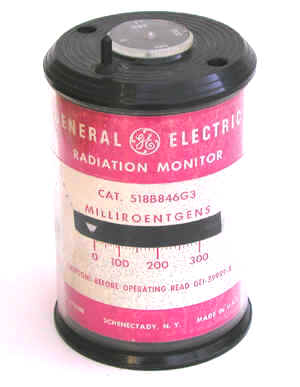General Electric Radiation Monitor (ca. 1952-1955)


The GE Radiation Monitor, Model 4SN11A3, seems to have been introduced in 1952. An earlier version, the Model 4SN11A2, dates at least from 1950. The date of the Model 5188846G3 (pictured above left) is somewhat uncertain. The collection contains an example of both the Model 4SN11A3, whose range is 0-20 mR, and the Model 5188846G3, the range of which is 0-300 mR.
It served as a self-contained portable monitor that didn’t require batteries or an external power supply. The exposure was determined by the position of the pointer on the front of the unit. The pointer, sandwiched between two “voltmeter” plates, is attached to a taut wire suspension that runs vertically along the central axis of the unit. The pointer and plates were charged by turning the monitor upside down. The electrostatic charge was generated by the movement of mercury in a glass tube. A toggle switch on top of the unit was used to zero the pointer.
Quoting a December 1950 AP press release:
"A new detector makes it possible for atomic workers to tell at a glance the amount of radiation in an area. It will warn of hazards in time for the workers to escape serious exposure, the General Electric Company said yesterday. The device, known as a "radiation monitor," weighs less than a pound and is about the size of a quart oil can."
The radiologist and employee of the General Electric Company, Dale Trout, described what led him to develop this instrument:
“I became aware of the fact that two things always seemed to happen [with radiation detectors]. The batteries were dead and somebody had lost the instructions. So George Shulte and I who were interested in this [field of] radiation protection, made an instrument which we thought was a great one; and, boy, we lost our shirts on it... The reading element was a quadrant electrometer... We charged it by rolling a bubble of mercury down an evacuated tube; we didn’t have any batteries to run down you see, and we put the instructions on the inside of the chamber. To do away with the instructions, you had to bust it... We sold these things for $39.50 and believe me, they fell flat. Two things I’m sure happened. No health physicist would be caught having his picture taken without a cutie-pie... [and] nobody believed that you could make anything for $39.50 that would work... we scrapped 3,000 of them.”
According to the 1953-1954 GE catalog, it sold for $49.50.
References
- Davis, D.M., Gupton, E.D. and Hart, J.C. Applied Health Physics Radiation Survey Instrumentation, ORNL-332 (1st Rev.), January 1954.
- Trout, D., in Health Physics: A Backward Glance (1980), ed. Kathren, R. and Ziemer, P. Pergamon Press, 1980.
- Advertisement of the model 4SN11A2 monitor in the December 1950 issue of Nucleonics (page 87).
- Advertisement for the model 4SN11A3 monitor in the August 1952 issue of Nucleonics (page 6).
- New Radiation Detector. Appeared in the Syracuse Herald Journal, December 14, 1950.
- General Electric Catalog. X-ray Supplies and Accessories. 1953-1954.
